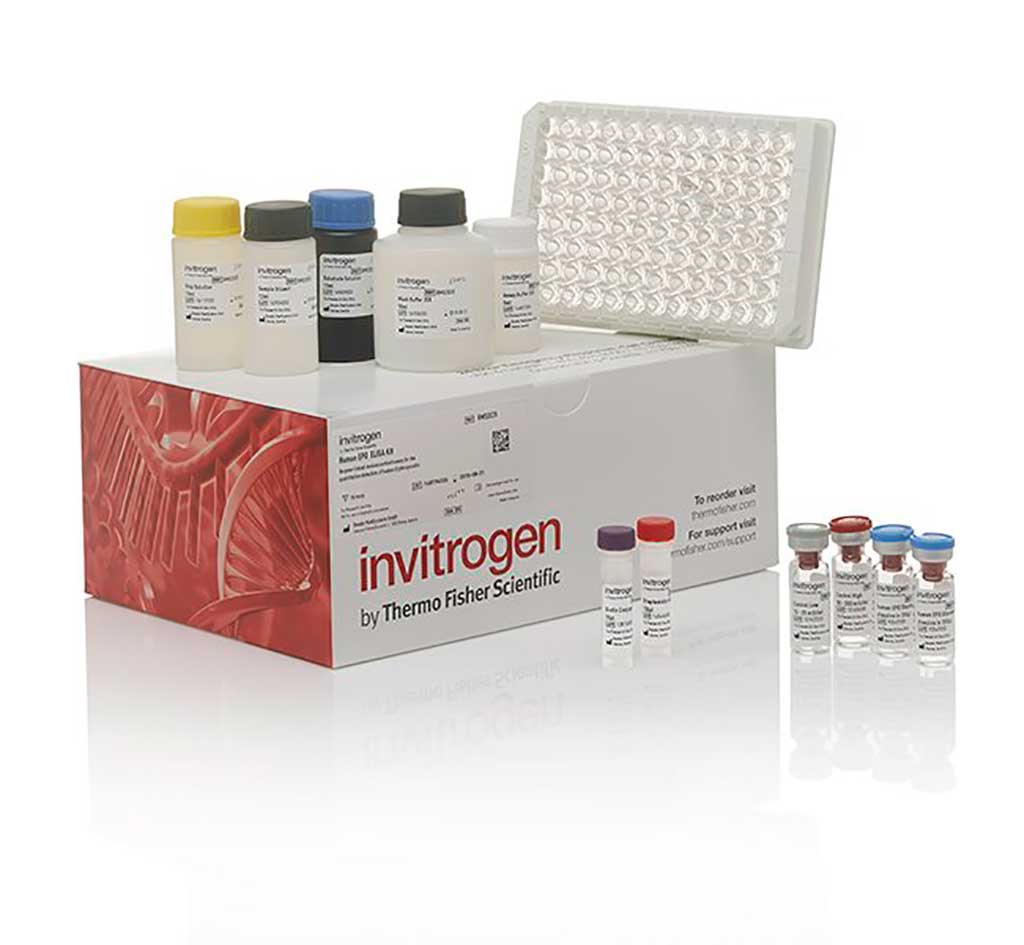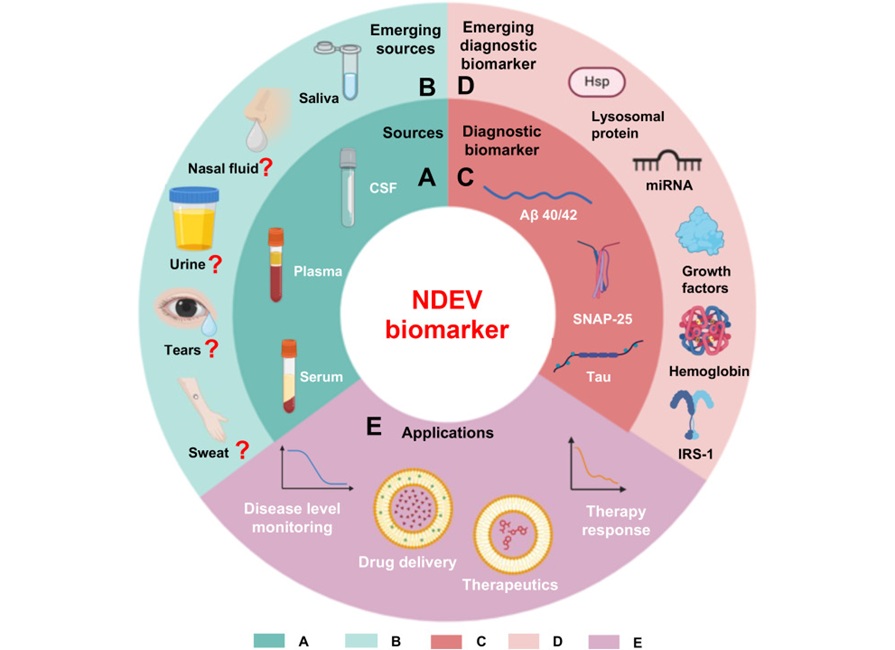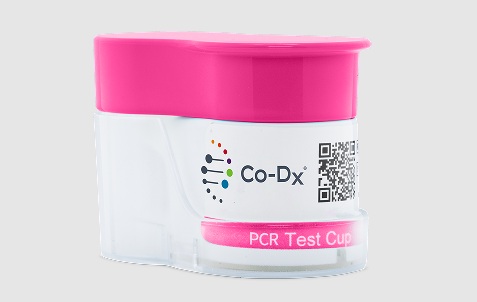Blood Biomarkers Help Diagnose Parkinson's Disease
|
By LabMedica International staff writers Posted on 05 May 2020 |

Image: The Clusterin Human ELISA kit (Photo courtesy of Invitrogen).
The identification of circulating biomarkers that closely correlate with Parkinson’s disease (PD) has failed several times in the past. A conventional pipeline for biomarker discovery usually contemplates the collection of clinical samples, such as blood, and their analysis by mass spectrometry.
However, clinical samples, in particular the case of plasma and serum, the primary source for biomarker discovery, are known to have a large dynamic range, which makes it difficult to reach the less abundant species. A translational approach has been conducted, allowing the evaluation of the plasma levels of two mitochondrial-related proteins, whose combination leads to a robust model with potential diagnostic value to discriminate the PD patients from matched controls.
Interdisciplinary scientists from the University of Coimbra (Coimbra, Portugal) examined blood plasma samples from 31 Parkinson’s patients, ages 65 to 86 and being followed at the Centro Hospitalar Cova da Beira (Covilhã, Portugal). They then compared these sample with 28 from matched controls, whose ages ranged from 55 to 83. The team started out by comparing proteins that are secreted by cells cultured in normal conditions, and in a setting of oxidative stress, an imbalance between the production and clearance of toxic reactive species that are harmful to cells, and which plays a key role in neurodegenerative diseases like Parkinson’s.
In total, their analysis retrieved 23 mitochondrial-related proteins that were differentially secreted by cells under these two conditions, including 19 proteins whose levels were significantly increased in the presence of oxidative stress, and four proteins with significantly decreased levels in this setting. This approach yielded a total of 98 proteins that were significantly different between patients and controls, but a review of mitochondrial-related proteins retrieved only two candidates, clusterin and the vacuolar protein sorting-associated protein 35 (VPS35). Levels of these two mitochondrial-related proteins combined were better than each single protein at discriminating patients from controls, showing an accuracy of 82.1%. The rate of incorrectly classified patients also dropped significantly when people with more advanced disease were examined.
Clusterin, VPS35, and GFP (the internal standard used in mass spectrometry analysis) levels were determined using ELISA commercial kits, namely Clusterin Human ELISA kit (Invitrogen, Carlsbad, CA, USA), Human Vacuolar protein sorting-associated protein 35 (VPS35) ELISA Kit (Abbexa, Cambridge, UK) and GFP ELISA Kit (Abcam, Cambridge, UK), respectively.
The authors concluded that an adaptation of a translational pipeline for biomarker selection was presented and transposed to neurological diseases. From the application of this adapted pipeline, two mitochondrial-related proteins were identified as potential candidates for Parkinson’s disease diagnosis. The study was published on April 3, 2020 in the journal Translational Neurodegeneration.
However, clinical samples, in particular the case of plasma and serum, the primary source for biomarker discovery, are known to have a large dynamic range, which makes it difficult to reach the less abundant species. A translational approach has been conducted, allowing the evaluation of the plasma levels of two mitochondrial-related proteins, whose combination leads to a robust model with potential diagnostic value to discriminate the PD patients from matched controls.
Interdisciplinary scientists from the University of Coimbra (Coimbra, Portugal) examined blood plasma samples from 31 Parkinson’s patients, ages 65 to 86 and being followed at the Centro Hospitalar Cova da Beira (Covilhã, Portugal). They then compared these sample with 28 from matched controls, whose ages ranged from 55 to 83. The team started out by comparing proteins that are secreted by cells cultured in normal conditions, and in a setting of oxidative stress, an imbalance between the production and clearance of toxic reactive species that are harmful to cells, and which plays a key role in neurodegenerative diseases like Parkinson’s.
In total, their analysis retrieved 23 mitochondrial-related proteins that were differentially secreted by cells under these two conditions, including 19 proteins whose levels were significantly increased in the presence of oxidative stress, and four proteins with significantly decreased levels in this setting. This approach yielded a total of 98 proteins that were significantly different between patients and controls, but a review of mitochondrial-related proteins retrieved only two candidates, clusterin and the vacuolar protein sorting-associated protein 35 (VPS35). Levels of these two mitochondrial-related proteins combined were better than each single protein at discriminating patients from controls, showing an accuracy of 82.1%. The rate of incorrectly classified patients also dropped significantly when people with more advanced disease were examined.
Clusterin, VPS35, and GFP (the internal standard used in mass spectrometry analysis) levels were determined using ELISA commercial kits, namely Clusterin Human ELISA kit (Invitrogen, Carlsbad, CA, USA), Human Vacuolar protein sorting-associated protein 35 (VPS35) ELISA Kit (Abbexa, Cambridge, UK) and GFP ELISA Kit (Abcam, Cambridge, UK), respectively.
The authors concluded that an adaptation of a translational pipeline for biomarker selection was presented and transposed to neurological diseases. From the application of this adapted pipeline, two mitochondrial-related proteins were identified as potential candidates for Parkinson’s disease diagnosis. The study was published on April 3, 2020 in the journal Translational Neurodegeneration.
Latest Immunology News
- Ultrasensitive Liquid Biopsy Demonstrates Efficacy in Predicting Immunotherapy Response
- Blood Test Could Identify Colon Cancer Patients to Benefit from NSAIDs
- Blood Test Could Detect Adverse Immunotherapy Effects
- Routine Blood Test Can Predict Who Benefits Most from CAR T-Cell Therapy
- New Test Distinguishes Vaccine-Induced False Positives from Active HIV Infection
- Gene Signature Test Predicts Response to Key Breast Cancer Treatment
- Chip Captures Cancer Cells from Blood to Help Select Right Breast Cancer Treatment
- Blood-Based Liquid Biopsy Model Analyzes Immunotherapy Effectiveness
- Signature Genes Predict T-Cell Expansion in Cancer Immunotherapy
- Molecular Microscope Diagnostic System Assesses Lung Transplant Rejection
- Blood Test Tracks Treatment Resistance in High-Grade Serous Ovarian Cancer
- Luminescent Probe Measures Immune Cell Activity in Real Time
- Blood-Based Immune Cell Signatures Could Guide Treatment Decisions for Critically Ill Patients
- Novel Tool Predicts Most Effective Multiple Sclerosis Medication for Patients
- Companion Diagnostic Test for CRC Patients Identifies Eligible Treatment Population
- Novel Tool Uses Deep Learning for Precision Cancer Therapy
Channels
Clinical Chemistry
view channel
Compact Raman Imaging System Detects Subtle Tumor Signals
Accurate cancer diagnosis often depends on labor-intensive tissue staining and expert pathological review, which can delay results and limit access to rapid screening. These conventional methods also make... Read more
Noninvasive Blood-Glucose Monitoring to Replace Finger Pricks for Diabetics
People with diabetes often need to measure their blood glucose multiple times a day, most commonly through finger-prick blood tests or implanted sensors. These methods can be painful, inconvenient, and... Read moreMolecular Diagnostics
view channel
Neuron-Derived Extracellular Vesicles Could Improve Alzheimer’s Diagnosis
Alzheimer’s disease is becoming increasingly common as global populations age, yet effective treatments for advanced stages remain limited. Early detection is therefore critical, but current diagnostic... Read more
Sample Prep Instrument to Empower Decentralized PCR Testing for Tuberculosis
Tuberculosis remains the deadliest infectious disease worldwide despite being both treatable and curable when diagnosed early. A major barrier to timely diagnosis is that PCR-based TB testing is still... Read more
Endometriosis Blood Test Could Replace Invasive Laparoscopic Diagnosis
Endometriosis affects an estimated 1 in 10 women globally, yet diagnosis can take 7 to 10 years on average due to the invasive nature of laparoscopy and lack of accurate, non-invasive tests.... Read more
World's First NGS-Based Diagnostic Platform Fully Automates Sample-To-Result Process Within Single Device
Rapid point-of-need diagnostics are of critical need, especially in the areas of infectious disease and cancer testing and monitoring. Now, a direct-from-specimen platform that performs genomic analysis... Read moreHematology
view channel
MRD Tests Could Predict Survival in Leukemia Patients
Acute myeloid leukemia is an aggressive blood cancer that disrupts normal blood cell production and often relapses even after intensive treatment. Clinicians currently lack early, reliable markers to predict... Read more
Platelet Activity Blood Test in Middle Age Could Identify Early Alzheimer’s Risk
Early detection of Alzheimer’s disease remains one of the biggest unmet needs in neurology, particularly because the biological changes underlying the disorder begin decades before memory symptoms appear.... Read more
Microvesicles Measurement Could Detect Vascular Injury in Sickle Cell Disease Patients
Assessing disease severity in sickle cell disease (SCD) remains challenging, especially when trying to predict hemolysis, vascular injury, and risk of complications such as vaso-occlusive crises.... Read more
ADLM’s New Coagulation Testing Guidance to Improve Care for Patients on Blood Thinners
Direct oral anticoagulants (DOACs) are one of the most common types of blood thinners. Patients take them to prevent a host of complications that could arise from blood clotting, including stroke, deep... Read moreMicrobiology
view channel
New UTI Diagnosis Method Delivers Antibiotic Resistance Results 24 Hours Earlier
Urinary tract infections affect around 152 million people every year, making them one of the most common bacterial infections worldwide. In routine medical practice, diagnosis often relies on rapid urine... Read more
Breakthroughs in Microbial Analysis to Enhance Disease Prediction
Microorganisms shape human health, ecosystems, and the planet’s climate, yet identifying them and understanding how they are related remains a major scientific challenge. Even with modern DNA sequencing,... Read morePathology
view channel
AI Tool Simultaneously Identifies Genetic Mutations and Disease Type
Interpreting genetic test results remains a major challenge in modern medicine, particularly for rare and complex diseases. While existing tools can indicate whether a genetic mutation is harmful, they... Read more
Rapid Low-Cost Tests Can Prevent Child Deaths from Contaminated Medicinal Syrups
Medicinal syrups contaminated with toxic chemicals have caused the deaths of hundreds of children worldwide, exposing a critical gap in how these products are tested before reaching patients.... Read more
Tumor Signals in Saliva and Blood Enable Non-Invasive Monitoring of Head and Neck Cancer
Head and neck cancers are among the most aggressive malignancies worldwide, with nearly 900,000 new cases diagnosed each year. Monitoring these cancers for recurrence or relapse typically relies on tissue... Read moreTechnology
view channel
AI Predicts Colorectal Cancer Survival Using Clinical and Molecular Features
Colorectal cancer is one of the most common and deadly cancers worldwide, and accurately predicting patient survival remains a major clinical challenge. Traditional prognostic tools often rely on either... Read more
Diagnostic Chip Monitors Chemotherapy Effectiveness for Brain Cancer
Glioblastoma is one of the most aggressive and fatal brain cancers, with most patients surviving less than two years after diagnosis. Treatment is particularly challenging because the tumor infiltrates... Read moreIndustry
view channel
BD and Penn Institute Collaborate to Advance Immunotherapy through Flow Cytometry
BD (Becton, Dickinson and Company, Franklin Lakes, NJ, USA) has entered into a strategic collaboration with the Institute for Immunology and Immune Health (I3H, Philadelphia, PA, USA) at the University... Read more



















